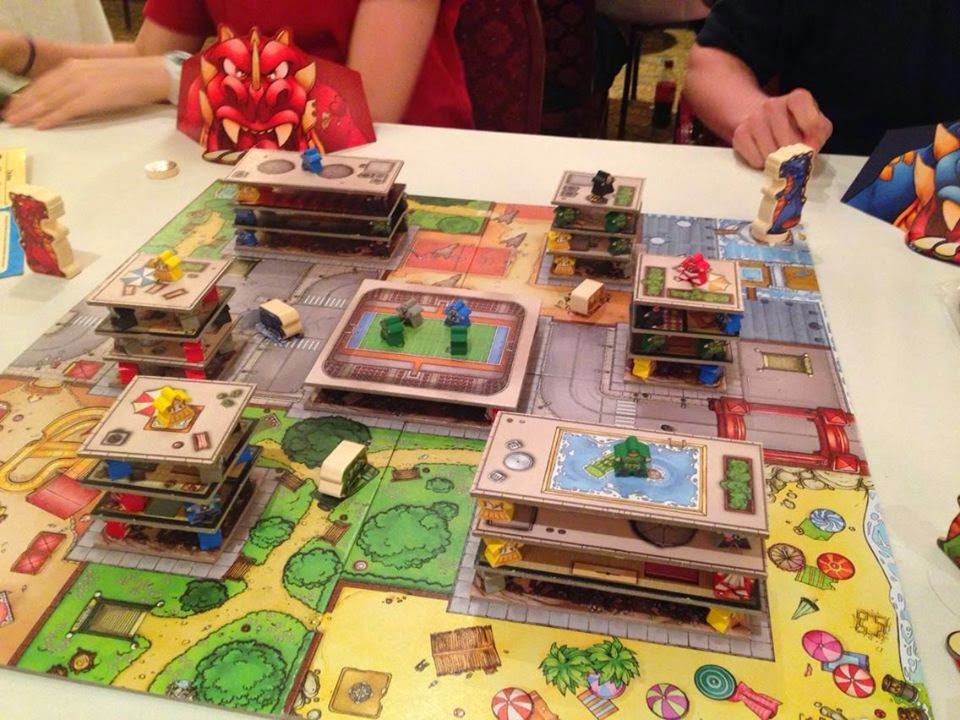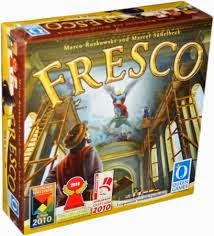Last night, I closed out playing Sentinels of the Multiverse with all the expansions. This is DC's answer to Marvel's Legendary.
Official description:
Sentinels of the Multiverse is a cooperative game in which players control heroes with powers and abilities in the form of cards. Two to five players control three to five heroes who must work together to defeat the villains and survive the dangerous environments in which the battles take place.Here is the box.

If you read my previous post, you'll remember that I thought Legendary was "meh." Sentinels of the Multiverse as I played it, despite having some cool bits, is a broken game. The bad guys are simply too tough. I think this is because we played the "big box" version with all sorts of add-ons that made the bad guys into hero-crunching murder machines.
However, the basic game may be fine. As I played a 3-person game, a 9-year old ran up and waxed rhapsodic about the game. He LOVED my character, Wraith, and thought that her equipment was awesome.
In fact, he was all: "Ohmygod! You've got Wraith! I love Wraith! She's so cool! And you've got her utility belt! Awesome. That's a great combination!"
So, maybe the basic game is better.
This is Wraith ...
Wraith is a Batman-type whose super-powers are in her utility belt. Here are some more characters from the game ...
One more thing: The art in the DC game is clearly inferior to the art in the Marvel game. To be sure, this is from an old man's perspective. Young kids like the 9-year-old may prefer the "Toon Channel" art style.
And don't think I'm against all card games. I closed out today (Sunday) by playing Among The Stars. I REALLY enjoyed this game.
Each player takes the role of one of an alien race trying to build the greatest space station. Through card drafting, the players select locations, and use these to build their station, scoring victory points based on the placement.
Among The Stars is an excellent game, with the round-robin card-trading trait of 7 Wonders. You are an alien race (with alien powers that let you bend the rules), and you build your space station from the cards you are dealt or trade with others. Here is what my space station looked like in the end.
Among the Stars is highly recommended.
Now let's look at a game with more fun than depth: The Doom That Came to Atlantic City. The cover describes it as "A light-hearted game of urban destruction in the universe of H.P. Lovecraft."
You're one of the Great Old Ones – beings of ancient and eldritch power. Cosmic forces have held you at bay for untold aeons, but at last the stars are right and your maniacal cult has called you to this benighted place. Once you regain your full powers, you will unleash your Doom upon the world!
There's only one problem: You're not alone. The other Great Old Ones are here as well, and your rivals are determined to steal your cultists and snatch victory from your flabby claws! It's a race to the ultimate finish as you crush houses, smash holes in reality.
Here is what the components look like. The individual monsters are awesome...
You know how in Monopoly you build Atlantic City? In this game, you play a Lovecraftian monster that is destroying Atlantic City, and attempting to bring about your own personal doom on the world.
The Doom that Came to Atlantic City (TDCAC) has an interesting story behind the game: It was a Kickstarter project that raised way more funds than was needed, then the person raising with the funds did not spend them to produce the game. The word "fraud" was thrown around. This shows the risks inherent with Kickstarter.
The good news: TDCAC is such a cool game, it was able to get beyond that crisis and get published anyway. The bad news: It's way too expensive for its asking price. Pick it up if you can find a real deal.
Speaking of lighthearted destruction, my family loved Rampage. In this game, you build "buildings" out of decks supported by meeples. You play a monster competing with other monsters to destroy the city and eat the meeples.
The official description:
In Rampage, you arrive in Meeple City as a gigantic, famished, scaly-skinned monster! Your goal: Dig your claws and dirty paws into the asphalt, destroy buildings, and devour innocent meeples – in short: sow terror while having fun. The monster who has caused the most damage after the carnage finally ends wins the game.Now for the controversy: Asmodee Games didn't get the rights to the name Rampage, which was the name of a very similarly themed old video game. Lawyers kinda frown on that stuff. No wait -- "frown" is the wrong word. I mean that Lawyers rub their hands with glee and chuckle and chortle while preparing to vacuum out your wallet.
The buildings in Meeple City are comprised of floor tiles and meeples, with the meeples serving as pillars that support the floors. Four wooden vehicles are on the ground in the eight neighborhoods in the city. Each monster, which consists of a wooden paws disc and a wooden body, starts in one corner of the game board. On a turn you take two actions from four possibilities, repeating an action if desired:
- Move: Pick up your monster body, flick the paws disc, then place the body back on the disc.
- Demolish: If your paws are on the sidewalk surrounding a building, you can pick up your monster body, drop it onto a building, then collect any floors that have no meeples on them.
- Toss a vehicle: If you're in a neighborhood with a vehicle, you can pick up the vehicle, place it on your body, then flick the vehicle at a building or another monster.
So, Asmodee is changing the name to "Terror in Meeple City." If you see a version with the old name, pick it up, because it's collectible (and a heck of a lot of fun).
I had a tremendously good time playing the car racing game Formula D with my wife, Cindy. a friend of hers (Jason) who knows the game talked us through it.
Here is the official description, which does not do this game justice:
Formula D is a high stakes Formula One type racing game where the players race simulated cars with the hope of crossing the finish line first. Each player shifts gears, with each gear providing a different speed. (For example, 4th gear is a die that rolls random numbers from 7 to 12 for spaces moved.) Each turn, players may move up one gear, stay in that gear, or move down gears. However, speed is not the only issue! Corners have a "stop" rule that requires players to stop once, twice, or three times on that corner in consecutive turns or face a penalty. This creates an effective speed limit to the corners.
Okay, here's the real deal: Every gear gets its own die: 6-sided, 8-sided, 12-sided and so on. So you're constantly picking a die and rolling against the odds to make your turns and out-race your opponents at the same time. We were both yelling by the end of this game -- yelling because we were having such a great time.
It's easy AND fun, and looks like it has lots of replay-ability. In fact, if you flip the board over, you get illegal street racing. Awesome!
In his descriptions/instructions, Jason kept emphasizing how if we did things wrong we would end up dying a fiery death. We need him to explain more games to us. He added to the fun.
A game I didn't get to play but it looks like a lot of fun is called Xia: Legends of a Drift System.
The Official Description:
Each player begins the game by choosing and customizing a Tier 1 starship. Invest all your money in engines and be a rapid, yet fragile, explorer. Put all your credits into an uber missile and watch other players flee in terror. Get a small engine and save space and credits to invest in buying and selling cargo. Or create a well rounded ship, ready for anything. In Xia, the choice is always yours. The goal is to become the most famous captain.
Here are the components ...
Pretty cool, overall.
Cindy and I also played Fresco, in which you are a master artist leading a team to restore a painting in a Renaissance church.
Each round in Fresco begins with players deciding what time they would like to wake up for the day. The earlier you wake up, the earlier you will be in turn order, and the better options you will be guaranteed to have. Wake up early too often, however, and your apprentices will become unhappy!
Then, players deploy their apprentice work force to various tasks. You'll need to buy paint, mix paint, work on painting the fresco, raise money by painting portraits, and perhaps even send your apprentices to the opera in order to increase their happiness. Points are scored mostly by painting the fresco, which requires specific combinations of paints, so you'll need to buy and mix your paints wisely, in addition to beating other players to the paints and frescos you would like to paint.
The game was fun, though I think it may not have a lot of replayability. Perhaps that's why there are already multiple expansions.
Cindy liked this game a lot, but I think she's moved on to Pastiche as her new favorite painting-themed game.
Fresco uses a mechanic where the person with the least points (last in line) gets to go first every turn). My view: Fresco is fun, but Tokaido does it better and faster (Ouch!)
I played more games, including a Wits & Wagers tournament led by Tom Vasel, which was tremendous fun. Now it's time to head back home. But we'll be back next year. This is too much fun to pass up.
First entry from Dice Tower Convention HERE.














No comments:
Post a Comment